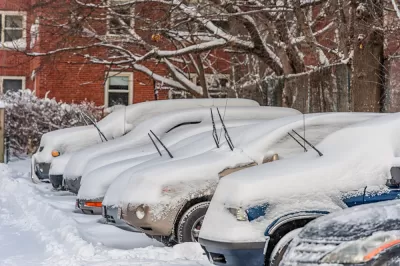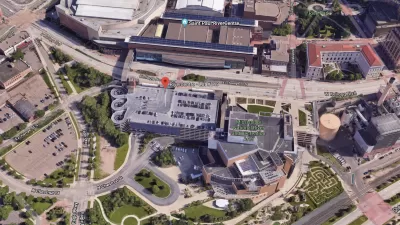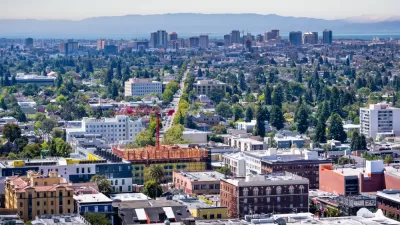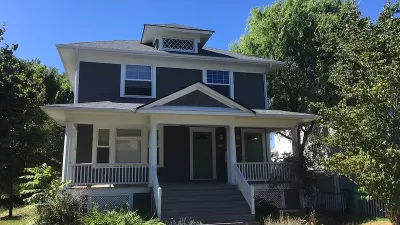Underutilized parking lots are a costly waste. By managing parking more efficiently, cities can free up land to house people rather than cars.

Our current laws do not mandate housing for people, but virtually all jurisdictions do mandate an abundant and costly supply of housing for motor vehicles. Our zoning codes require that most buildings include numerous parking spaces that are generally unpriced, which is a huge and unfair subsidy for automobile use. This increases housing costs, encourages driving, and forces car-free households to pay for expensive parking facilities they don't need.
The costs are huge. Recent studies have counted the number of parking spaces that exist in various areas. They indicate that there are typically 3-6 off-street parking spaces per motor vehicle, with lower rates in central cities and higher rates in sprawled areas. Considering land, construction and operating expenses, a typical surface parking space has an annualized cost of $500-1,500, and structured parking costs about three times as much. Yet, most of this parking is unpriced, provided free. Every time somebody purchases a vehicle they expect somebody else—businesses and local governments—to provide thousands of dollars worth of parking for its use, a matching grant for driving.
Parking facilities are the dark matter of the urban universe; they represent a major portion of total urban land and affect virtually every aspect of urban life including development patterns, housing costs, travel activity, walkability, environmental quality, and aesthetics. Yet, to most people, parking is virtually invisible, a huge and costly resource that they only notice when they have trouble finding a space.

A large portion of urban land is devoted to off-street parking facilities. With more efficient management, this could be used for housing.
According to a major study, Parking Infrastructure: A Constraint on or Opportunity for Urban Redevelopment? A Study of Los Angeles County Parking Supply and Growth, 14% of Los Angeles land is devoted to parking. Their results are illustrated below.

What does this indicate about our communal values? We consider housing for automobiles a necessity that, by law, everybody must subsidize, while housing for people is optional, to be financed by users or subsidized at whatever level governments can fit into their budgets. This helps explain why so many cities have a housing unaffordability crisis.
A city is, by definition, a place where many people and activities occur close together. As a result, urban land is always scarce and precious. A smart city manages this resource to maximize benefits. Parking regulations are generally applied without consideration to context; the same requirements are imposed in multimodal neighborhoods with land value areas as in sprawled, automobile-dependent areas. In other words, conventional parking policies impose suburban values in urban environments where they are inappropriate.
This is a good time to reform our vehicle parking policies for affordability and efficiency. These reforms don't eliminate parking supply, but they make parking facilities work harder, so parking lots serve multiple destinations and achieve higher occupancy rates, which reduces the number of spaces needed to serve demands. The table below summarizes various parking management strategies that can increase efficiency and fairness.
|
Strategy |
Description |
Typical Reduction |
|
Shared Parking |
Parking spaces serve multiple users and destinations. |
10-30% |
|
Parking Regulations |
Regulations favor higher-value uses such as service vehicles, deliveries, customers, quick errands, and people with special needs. |
10-30% |
|
More Accurate and Flexible Standards |
Adjust parking standards to more accurately reflect demand in a particular situation. |
10-30% |
|
Parking Maximums |
Establish maximum parking standards. |
10-30% |
|
Remote Parking |
Provide off-site or urban fringe parking facilities. |
10-30% |
|
Encourage more compact, mixed, multi-modal development to allow more parking sharing and use of alternative modes. |
10-30% |
|
|
Walking and Cycling Improvements |
Improve walking and cycling conditions to expand the range of destinations serviced by a parking facility. |
5-15% |
|
Increase Capacity of Existing Facilities |
Increase parking supply by using otherwise wasted space, smaller stalls, car stackers and valet parking. |
5-15% |
|
Mobility Management |
Encourage more efficient travel patterns, including changes in mode, timing, destination and vehicle trip frequency. |
10-30% |
|
Parking Pricing |
Charge motorists directly and efficiently for using parking facilities. |
10-30% |
|
Improve Pricing Methods |
Use better charging techniques to make pricing more convenient and cost effective. |
Varies |
|
Financial Incentives |
Provide financial incentives to shift mode such as parking cash out. |
10-30% |
|
Unbundle Parking |
Rent or sell parking facilities separately from building space. |
10-30% |
|
Parking Tax Reform |
Change tax policies to support parking management objectives. |
5-15% |
|
Bicycle Facilities |
Provide bicycle storage and changing facilities. |
5-15% |
|
Improve Information and Marketing |
Provide convenient and accurate information on parking availability and price, using maps, signs, brochures and the Internet. |
5-15% |
|
Improve Enforcement |
Insure that regulation enforcement is efficient, considerate and fair. |
Varies |
|
Transport Management Assoc. |
Establish member-controlled organizations that provide transport and parking management services in a particular area. |
Varies |
|
Overflow Parking Plans |
Establish plans to manage occasional peak parking demands. |
Varies |
|
Address Spillover Problems |
Use management, enforcement and pricing to address spillover problems. |
Varies |
|
Parking Facility Design and Operation |
Improve parking facility design and operations to help solve problems and support parking management. |
Varies |
This table summarizes the parking management strategies described in this report. It indicates the typical reduction in the amount of parking required at a destination, and whether a strategy helps reduce vehicle traffic, and so also provides congestion, accident and pollution reduction benefits.
Efficient parking management can significantly reduce housing development costs and free up a lot of urban land for other uses, including affordable housing. You can think of underutilized parking lots as a land bank for affordable urban infill. If unaffordability is a problem, parking management is the solution!
Many studies indicate that conventional parking minimums result in far more spaces than are really needed, particularly for affordable housing in multimodal neighborhoods. For example, a recent study of multifamily developments in the Denver region found that 40% of spaces in market-based buildings and 50% of spaced in below-market buildings are virtually never used. A study of 27 mixed-use districts around the United States found that parking is oversupplied by 65% on average. A Seattle study found that developers built about 40% fewer parking spaces when parking minimums were eliminated in central neighborhoods. This research indicates that many urban developments could significantly reduce their parking supply, particularly if they implemented parking management programs, which could free up a lot of land for affordable housing.
Here's one way to think about this issue. Most cities require between one and two parking spaces per housing unit, including secondary suites, townhouses and apartments. A typical off-street parking space is 10 x 20 feet and so requires about 200 square feet of land, and about double that to include driveways and access lanes. Assuming this totals about 333 per parking space, each parking space uses as much land as a 1,000 square foot three-story townhouse or apartment building. Requiring just one off-street doubles the amount of land required per housing unit.
Parking typically represents 10-20% of total housing costs. A major study using data from the American Housing Survey found that parking facilities cost renter households approximately $1,700 per year, adding 17% to an average unit's rent. This portion is higher for lower-priced housing in areas with high land prices. For example, two $50,000 parking spaces represent just 10% of the cost of a million dollar home, but one $40,000 space represents 20% of the cost of a basic $200,000 condominium. If parking represents 20% of residential development costs and parking supply is 50% higher than demand, more efficient parking management can reduce housing costs by 10% or more. For households that do not own an automobile, efficient parking requirements and unbundling parking can reduce housing costs by 10-20%.
This is a timely issue. Many cities want more affordable housing. In addition, automobile travel is peaking, and many jurisdictions have vehicle travel reduction targets, and are implementing Transportation Demand Management and Smart Growth development policies. Together, these trends justify making land currently dedicated to parking available for other uses.
There are many ways to make this happen. Our city is currently experiencing a homeless crisis, and so allowed unhoused people to camp in some city parks, which harms the parks, and caused flooding problems during heavy rains. City officials and a team of volunteers moved the tents to wood platforms built on the unused portion of a parking lot.
Another group is currently fundraising to build 30 container or modular houses to provide more comfortable housing. Such housing is relatively inexpensive, as low as $12,500 per home, and can be quickly installed, but requires sufficient land. Where? Underutilized parking lots are the obvious answer. However, such housing is suboptimal for long-term use. Container houses are small and energy inefficient, and therefore only suitable for temporary homes. Unless stacked, which adds costs, they are not very land efficient.
The best solution for permanent, affordable urban infill housing are generally missing middle types, such as townhouses and low-rise apartments. These are resource-efficient and generally have the lowest total costs, considering land, construction and future operating expenses. For example, a quarter-acre (10,000 square foot) parcel that currently accommodates about 30 parking spaces can instead hold 15-20 apartments averaging 1,000 square feet in a three- or four-story building, and still leave half of the parcel in green space, provided that residents can be satisfied with the five on-street parking spaces (eight if it is a corner lot), which avoids the costs and land requirements of off-street parking. This is typically sufficient for lower-income households living in walkable urban neighborhoods where many households are car-free.
Cities can create more affordable housing by eliminating parking minimums and encouraging property owners to replace underutilized parking lots with moderate-priced housing. Even if the new units are initially not affordable to lower-income households, they increase overall affordability through filtering, as some of the new occupants move from nearby lower-priced housing, making it available to new families.
When land uses are ranked by their environmental, social and aesthetic values, natural green space is generally highest, followed by gardens and lawns, then buildings and public streets, and at the bottom are private parking lots, which are ecologically and socially sterile and ugly. They also increase stormwater management costs and heat island effects. The less land that a city can devote to parking the better. Let's bust some pavement!
Next time you see an ugly, underutilized parking lot, think of it as a land bank for beautiful, affordable homes. Housing for people, not vehicles!
For More Information
CNT (2006), Paved Over: Surface Parking Lots or Opportunities for Tax-Generating, Sustainable Development? Center for Neighborhood Technology.
CNT (2016), Stalled Out: How Empty Parking Spaces Diminish Neighborhood Affordability, Center for Neighborhood Technology.
Alan During (2013), Apartment Blockers: Parking Rules Raise Your Rents, Sightline Institute.
G. J. Gabbe and Gregory Pierce (2016), “Hidden Costs and Deadweight Losses: Bundled Parking and Residential Rents in the Metropolitan United States,” Housing Policy Debate. Also see, “The Hidden Costs of Bundled Parking,”Access Magazine.
Todd Litman (2019), Pavement Busters Guide, Victoria Transport Policy Institute.
Todd Litman (2020), Parking Requirement Impacts on Housing Affordability, Victoria Transport Policy Institute.
Todd Litman (2021), Parking Management: Comprehensive Implementation Guide, Victoria Transport Policy Institute.
Parking Reform Network is a non-profit organization that advocates for efficient and equitable parking policies.
Daniel Rowe, et al. (2013), “Do Land Use, Transit and Walk Access Affect Residential Parking Demand?” ITE Journal, Vol. 83. No. 2, February, pp. 24-28. This article summarizes the results of King County’s Right Size Parking Project (www.rightsizeparking.org/index.php).
Robert J. Schneider, Susan L. Handy and Kevan Shafizadeh (2014), “Trip Generation for Smart Growth Projects,” ACCESS 45, pp. 10-15. Also see the Smart Growth Trip-Generation Adjustment Tool.
Rachel Weinberger and Joshua Karlin-Resnick (2019), “Parking In Mixed-Use U.S. Districts: Oversupplied No Matter How You Slice The Pie,” Transportation Research Record, 2537, pp. 177-184 (DOI: 10.3141/2537-19).

Maui's Vacation Rental Debate Turns Ugly
Verbal attacks, misinformation campaigns and fistfights plague a high-stakes debate to convert thousands of vacation rentals into long-term housing.

Planetizen Federal Action Tracker
A weekly monitor of how Trump’s orders and actions are impacting planners and planning in America.

In Urban Planning, AI Prompting Could be the New Design Thinking
Creativity has long been key to great urban design. What if we see AI as our new creative partner?

Portland Raises Parking Fees to Pay for Street Maintenance
The city is struggling to bridge a massive budget gap at the Bureau of Transportation, which largely depleted its reserves during the Civd-19 pandemic.

Spokane Mayor Introduces Housing Reforms Package
Mayor Lisa Brown’s proposals include deferring or waiving some development fees to encourage more affordable housing development.

Houston Mayor Kills Another Bike Lane
The mayor rejected a proposed bike lane in the Montrose district in keeping with his pledge to maintain car lanes.
Urban Design for Planners 1: Software Tools
This six-course series explores essential urban design concepts using open source software and equips planners with the tools they need to participate fully in the urban design process.
Planning for Universal Design
Learn the tools for implementing Universal Design in planning regulations.
Gallatin County Department of Planning & Community Development
Heyer Gruel & Associates PA
JM Goldson LLC
City of Camden Redevelopment Agency
City of Astoria
Transportation Research & Education Center (TREC) at Portland State University
Jefferson Parish Government
Camden Redevelopment Agency
City of Claremont






























